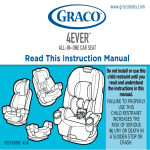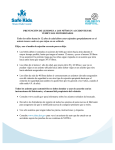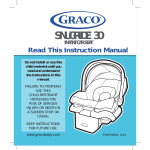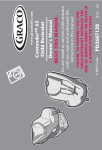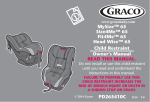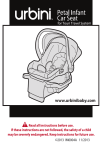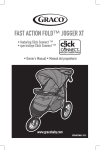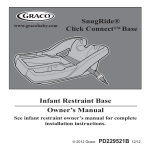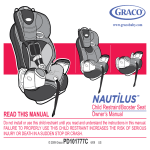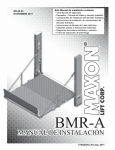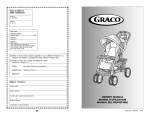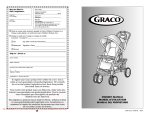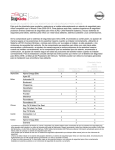Download 3 - Graco
Transcript
Do not install or use this child restraint until you read and understand the instructions in this manual. FAILURE TO PROPERLY USE THIS CHILD RESTRAINT INCREASES THE RISK OF SERIOUS INJURY OR DEATH IN A SUDDEN STOP OR CRASH. KEEP INSTRUCTIONS FOR FUTURE USE. www.gracobaby.com PD286920A 9/14 Important Pages 4-11 1-A Quick Guide to Your Manual 1-B Before You Begin 1-C Safety Warnings Features 2-A 2-B 2-C 2-D 2-E 2-F 2-G Pages 12-17 Base Features Remove Car Seat from Base Attach Car Seat to Base Recline the Base Choosing Vehicle Seat Location Choosing LATCH or Seat Belt What Is LATCH 2 Rear-Facing Use Pages 18-31 3-A Rear-Facing Checklist 3-B Install With Base With LATCH Strap 3-C Install With Base With Vehicle Seat Belt Vehicle Information 4-A 4-B 4-C 4-D Additional LATCH Information How to Remove LATCH Unsafe Vehicle Seats Vehicle Seat Belts 3 Pages 32-42 1 Important 1-A Quick Guide to Your Manual This base can be used with Graco® SnugRide Click Connect™ 22, 30, 35 and 40. When using the SnugRide Click Connect 40, the child’s height is limited to 32 inches (81 cm). Get to Know Your Base Review section 2-A to see all of the features of this base. What Seating Location Should I Use? The best seating location for this infant car seat base is one that: • Is recommended by your vehicle owner’s manual, and • Results in a secure installation of this base. Never place a child rear-facing in a seating position with an active front air bag. Review section 4 of this manual AND your vehicle owner’s manual. Which Installation Method Should I Use? This infant car seat base can be installed in your vehicle using either the vehicle seat belt OR the LATCH system. Both are equally safe to use. DO NOT USE BOTH AT THE SAME TIME. 4 When Installing Base Vehicle Seat Belt There are two types of vehicle seat belts that can be used. Lap/Shoulder Seat Belt or Lap Only Seat Belt. Review section 3-B of this manual AND your vehicle owner’s manual. Review section 3-C of this manual AND your vehicle owner’s manual. 5 1 Important LATCH System LATCH consists of lower anchors, which are built-in to your vehicle, and connecting hooks that are built-in your base. 1 Important 1-B Before You Begin Your child’s safety depends on you. No car seat can guarantee protection from injury in every situation, but proper use helps reduce the risk of serious injury or death. Even if this base seems easy to figure out on your own, you must follow the detailed instructions in this instruction manual to ensure the steps below are performed correctly. Register This Child Restraint Please fill out the prepaid registration postcard attached to the harness and mail it in today or register online at www. gracobaby.com/carseatregistration. Child restraints could be recalled for safety reasons. You must register this restraint to be reached in a recall. Send your name, address, and the restraint’s model number and manufacturing date to: Graco Children’s Products, Inc. Attn: Customer Service 3 Glenlake Parkway Atlanta, GA 30328 or call 1-800-345-4109 or register online at www.gracobaby.com/carseatregistration For recall information, call the U.S. Government’s Vehicle Safety Hotline at 1-888-327-4236 (TTY: 1–800–424–9153), or go to http://www.NHTSA.gov. 6 Model Name__________________________ Model Number________________________ Date of Manufacture___________________ Date of Purchase______________________ If You Need Help In the U.S.A, please contact our Customer Service Department with any questions you may have concerning parts, use, or maintenance. When you contact us, please have your product’s model number and date of manufacture ready so that we may help you efficiently. These numbers can be found on a sticker on the base. For additional resources or to get your car seat checked by a child passenger safety technician, please visit the following web sites: www.nhtsa.gov • www.seatcheck.org • www.safekids.org 7 1 Important For future reference or if you change addresses, record the model name, model number, date of manufacture, and purchase date of this base below. You can find this information either on the registration card if you still have it or on the date label located on the base. 1 Important Car Seat’s Useful Life STOP using this base and throw it away 7 years after the date of manufacture. Look for date of manufacture label on the base. Graco Children’s Products Inc. advises against loaning or passing along a car seat unless you know the complete history of the product. We also advise against purchasing a car seat second hand. Vehicle Seat Protection Protect vehicle seat. Use a car seat mat, towel, or thin blanket under and behind base. 8 No car seat can guarantee protection from injury in every situation, but proper use helps reduce the risk of serious injury or death. READ THIS MANUAL CAREFULLY. Failure to follow these instructions and child restraint’s labels can result in child striking the vehicle’s interior during a sudden stop or crash. ! NEVER PLACE THIS CHILD RESTRAINT REAR-FACING IN A VEHICLE SEATING LOCATION THAT HAS AN ACTIVE FRONT AIR BAG. If an air bag inflates, it can hit the child and car seat with great force and cause serious injury or death to your child. ! Review your vehicle owner’s manual for more information about air bags and car seat use. 9 1 Important 1-C Safety Warnings 1 Important ! If your vehicle does not have a back seat, review your vehicle owner’s manual. ! The American Academy of Pediatrics (AAP) and National Highway Traffic Safety Administration (NHTSA) recommend that children be rear-facing until age 2 or until they reach the maximum rearfacing height and weight rating for their seat. ! Select a suitable location for the base in your vehicle. ! Secure base with a vehicle seat belt or LATCH that is properly routed as shown in this manual. ! Vehicle seat belt system MUST hold base securely. Not all vehicle seat belts can be used with a base. ! If vehicle seat belt does not hold base securely, read “Vehicle Seat Belts” section 4 and your vehicle owner’s manual. ! Always secure base with LATCH or a vehicle seat belt, even when unoccupied. In a crash, an unsecured base can injure passengers. ! DO NOT use base if it is damaged or missing parts. 10 11 1 Important ! If base is in a crash, it must be replaced. DO NOT use it again! A crash can cause unseen damage and using it again could result in serious injury or death. ! DO NOT use accessories or parts other than those provided by Graco. Their use could alter the performance of the base. ! DO NOT remove LATCH system from base. If using vehicle seat belt to secure base, LATCH connectors must be stored. ! Rear-facing car seat must be properly leveled: • Too reclined can result in injury or ejection. • Too upright can result in breathing difficulties. ! Never attach two LATCH connectors to one vehicle lower anchor point unless specifically allowed by the vehicle manufacturer. ! Do not use both the vehicle seat belt and LATCH strap at the same time. 2-A Base Features A 2 Features B C D E F 12 A Car Seat Base Lock B Base Rear-Facing Belt Path C LATCH Strap D Instruction Manual Storage (Under Base) E LATCH Storage F Base Recline Wedge (on select models) 2-B Remove Car Seat from Base 1. To Remove Car Seat from Base From the back of the car seat, squeeze the base release handle and lift the car seat out of the base. 2-C Attach Car Seat to Base 2 Features 2. Attaching Car Seat To Base Align the locking bar at the front of the car seat with the locks in the base. Set car seat in the base. Push down on the front of the car seat. You will hear a “click” when it is locked. Pull up on the front corners of the seat to make sure it is locked. 13 2-D Recline the Base (on select models) 1. Base Has 3 Recline Positions 2 Features 1 Position 1 is the least reclined position. Remove the base wedge. For position 2, attach the base wedge with the label marked 2 facing up. 2 14 For position 3, attach the base wedge with the label marked 3 facing up. 3 2 Features With or without the base wedge, if needed, rolled towels may be placed under the base, at the vehicle seat crease, until the level line is level with the ground. 15 2-E Choosing Vehicle Seat Location Review your vehicle owner’s manual for seating locations. Review section 4 for additional information. 2 Features Some vehicles have specific requirements for where the car seat can be installed. Be sure to check your vehicle owner’s manual for all available seating positions. According to accident statistics, the safest place for your child in any vehicle is the back seat. The center of the back seat can be the safest during a possible side impact. NEVER place this child restraint rearfacing in a vehicle seating location that has an active front air bag. In the event there is no back seat, review your vehicle owner’s manual to see how to use your infant child restraint. 16 2-F Choosing LATCH or Seat Belts This base can be installed in your vehicle using either the vehicle seat belt OR the LATCH system. Both systems are equally safe to use. DO NOT USE BOTH AT THE SAME TIME. Review section 4 for additional information. 2-G What is LATCH? Review your vehicle’s owner manual for exact location and use. Review section 4 for additional information. Typical seat in a passenger vehicle. Other vehicle types may have different LATCH locations. Vehicle Lower Anchor Points Vehicle Seat Crease 17 2 Features LATCH consists of lower anchors, which are built-in to your vehicle, and connecting hooks that are built-in to your base. Lower anchors are used INSTEAD of the vehicle’s seat belt to secure the child seat to the vehicle. 3-A Rear-Facing Safe Use Checklist Rear-Facing: • Make sure LATCH strap or vehicle seat belt is routed through the rear-facing belt path, marked with a blue label. • Install this base tightly in your vehicle. Base should not move at the belt path more than 1” (2.5 cm) from side to side and front to back. • Check the level line to make sure the line is level with the ground. LATCH Strap 3 Rear Facing Vehicle Lap/Shoulder Seat Belt 18 Note: Preterm or low birth weight infants may be at special risk in a vehicle or aircraft. According to the AAP, these infants may suffer breathing issues if improperly reclined in a car seat. Use the corrected age for preemies. Graco advises that you have your physician or hospital staff evaluate your infant and recommend the proper car seat or car bed before you and your infant leave the hospital. Vehicle Lap Only Seat Belt NEVER place this child restraint rear-facing in a vehicle seating location that has an active front air bag. 3 Rear Facing 19 3-B Install With Base Rear-Facing With LATCH Strap Review your vehicle’s owner manual for LATCH location and use. 1. Remove LATCH Hooks from Storage Location Slide each LATCH hook out of the storage location. 3 Rear Facing 2. Make Sure LATCH Strap is in the Rear-Facing Belt Path, Marked With a Blue Label 20 3. Extend the LATCH Strap Extend the LATCH strap to its maximum length by pressing the gray button and pulling on the strap. 4. Place Base in Back Seat of the Vehicle Place the base flat on the vehicle seat. Push it back until the front of the base touches the vehicle seat back. Center the base between the lower LATCH anchors. 3 Rear Facing 21 5. Check the Rear Facing Level Line The red level line on the side of the seat MUST BE LEVEL with the ground. To recline, review section 2-D. 6. Connect LATCH Hooks to Vehicle’s Lower LATCH Anchors LATCH strap should lay as flat as possible and not be twisted. 3 Rear Facing 7. Tighten the LATCH Strap Press down firmly in the center of the base while tightening the LATCH strap. 22 8. Test For Tightness Grab the sides of the base where the LATCH strap is and push and pull the base from side to side and front to back. If the base moves less than 1” (2.5 cm), it is tight enough. 9. Attach Car Seat to Base CLICK! 23 3 Rear Facing Place car seat into the base. Push down on the front of the car seat and handle until you hear a “click”. Test to make sure the car seat is attached by pulling up on the front corners of car seat. 10. Check the Rear Facing Level Line 3 Rear Facing The red level line on the side of the seat MUST BE LEVEL with the ground. Check the level line with child in the child restraint when making sure the line is level with the ground. 24 Is Everything Correct? Base Does Not Move More Than 1” (2.5 cm) At The Belt Path Car Seat Is Properly Attached To Base Car Seat Level to Ground 3 Rear Facing 25 3-C Install With Base Rear-Facing With Vehicle Seat Belt 1. Store LATCH Straps Hook the LATCH hooks into the holes on side of base as shown. Remove the slack. 2. Place Base in Back Seat of the Vehicle 3 Rear Facing Place the base flat on the vehicle seat. Push it back until the front of the base touches the vehicle seat back. 26 3. Check the Rear Facing Level Line The red level line on the side of the seat MUST BE LEVEL with the ground. To recline, review section 2-D. Review your vehicle’s owner manual for vehicle seat belt use 4. Route the Vehicle Seat Belt 27 3 Rear Facing Thread vehicle seat belt through the rear-facing belt path (marked with a blue label) and buckle it. The seat belt should lay as flat as possible and not be twisted. 5. Lock the Vehicle Seat Belt In most vehicles today, slowly pull the shoulder belt all the way out and then let it go back in. You will hear a “clicking” sound. Slowly pull out on the belt and it should be locked. If not, review your car’s owner manual and section 4-D. 6. Tighten the Vehicle Seat Belt 3 Rear Facing Press down firmly in the center of the base. Pull on the shoulder belt to tighten while feeding the slack back in the retractor. 28 7. Test For Tightness Grab the sides of the base where the seat belt is and push and pull the base from side to side and front to back. If the base moves less than 1” (2.5 cm), it is tight enough. 8. Attach Car Seat to Base CLICK! Place car seat into the base. Push down on the front of the car seat and handle until you hear a “click”. Test to make sure the car seat is attached by pulling up on the front corners of car seat. 3 Rear Facing 29 9. Check the Rear Facing Level Line The red level line on the side of the seat MUST BE LEVEL with the ground. 3 Rear Facing Check the level line with child in the child restraint when making sure the line is level with the ground. 30 Is Everything Correct? Base Does Not Move More Than 1” (2.5 cm) At The Belt Path Car Seat Is Properly Attached To Base Car Seat Level to Ground 3 Rear Facing 31 4 Vehicle Information 4-A Additional LATCH Information This base can be installed in your vehicle using either the vehicle seat belt OR the LATCH system. Both systems are equally safe to use. DO NOT USE BOTH AT THE SAME TIME. The LATCH system allows you to securely attach your base in your car without using the vehicle seat belt and possibly to get a better fit. All 2003 and newer model year vehicles are required to have a LATCH system, although some manufacturers began including LATCH earlier. Some vehicle owner manuals use the term ISOFIX to identify the LATCH system. Only use LATCH in seating positions recommended by your vehicle manufacturer. Review your vehicle owner’s manual for more information. 32 1. Push Gray Button In While Pulling on LATCH Strap to Loosen 2. Press and Hold LATCH Release Hinge 3. Push Hook In, Lift Hook Up and Pull Out Away From Anchor Point 33 4 Vehicle Information 4-B How to Remove LATCH 4 Vehicle Information 4-C Unsafe Vehicle Seats Never install this base in side-facing or rear-facing vehicle seats. 4-D Vehicle Seat Belts Review your vehicle owner’s manual for vehicle seat belt use This base can be installed using a vehicle seat belt. To do this, you will need to change the seat belt to a locked mode for use with a base. With some vehicle seat belts, this is done with the latch plate; with other vehicle seat belts, this is done with the retractor. 34 Vehicle Seat Belt Terms 4 Vehicle Information Retractor A device that winds up the unused vehicle seat belt. It is often hidden inside the panels on the walls of the vehicle or in the vehicle seat back. Latch Plate The male end of the seat belt with the silver tongue. Seat Crease The crease where the vehicle seat back and seat bottom meet. Identify Your Seat Belt Type There are two different types of vehicle seat belts that can be used with this base: Lap/Shoulder Seat Belt 3 connections points. Lap Only Seat Belt 2 connection points. 35 4 Vehicle Information The following types of vehicle seat belts CANNOT be used safely with this base: Lap Belt with Motorized Shoulder Belt Belts Forward of the Seat Crease Lap Belt or Shoulder Belt Mounted on Door 36 Lap/Shoulder Seat Belt Installation 37 4 Vehicle Information Always review your vehicle owner’s manual for specific information about your vehicle seat belts. There are three types of retractors: ELR (Emergency Locking Retractor), ALR (Automatic Locking Retractor), and Switchable (ELR switch to ALR). To determine your type of retractor, follow these steps: 1. Slowly pull the belt out about halfway and stop. 2. Let the belt retract back several inches. 3. Try to slowly pull the belt out more. If the belt cannot be pulled any further, it is ALR, ready to install your base. If it can be pulled further, go to the next step. 4. Slowly pull the belt all the way out, and then allow it to retract several inches. You may hear some clicking sounds. 5. Try to pull the belt all the way out again. If it cannot be pulled out, it is Switchable, ready to install your base. If it can still be pulled out freely, it is ELR. Review the following pages to properly install your infant base. Note: Most vehicles manufactured after 1996 will have Switchable retractors in the back seat. If you have any questions about your retractor type, consult your vehicle owner’s manual or call Graco for assistance. 4 Vehicle Information How to Lock Your Lap/Shoulder Vehicle Seat Belt Sliding Latch Plate and Switchable Retractor Note: With the vehicle seat belt in this locking mode, all the tension is upwards in the shoulder belt. This may start to tilt your base sideways. If this happens, use a locking clip instead of switching the retractor. See Sliding Latch Plate and ELR Retractor. 38 A latch plate that slides freely on the belt webbing and cannot, by itself, hold the belt snug around a base. When installing the base, route the vehicle seat belt through the proper belt path and buckle it in. Slowly pull the shoulder belt all the way out to switch it to locking mode. Then, as you pull the vehicle seat belt tight, feed all the slack back into the retractor. Grab the sides of the base at the belt path and slide side to side and front to back. The base should not move more than 1” (2.5 cm). 4 Vehicle Information Locking Latch Plate and ELR Retractor A latch plate that holds the lap belt snug after it has been adjusted; contains a metal bar on the underside of the hardware that “locks” the belt in position. When installing the base, route the vehicle seat belt through the proper belt path and buckle it in. Then, pull upwards on the shoulder belt so that the lap belt gets tight around the base. Grab the sides of the base at the belt path and slide side to side and front to back. The base should not move more than 1” (2.5 cm). 39 4 Vehicle Information Sliding Latch Plate and ALR Retractor A latch plate that slides freely on the belt webbing and cannot, by itself, hold the belt snug around a base. Slowly pull the shoulder belt all the way out. Route the vehicle seat belt through the proper belt path and buckle it in. Then, as you pull the vehicle seat belt tight, feed all the slack back into the retractor. Grab the sides of the base at the belt path and slide side-to-side and front-to-back. The base should not move more than 1” (2.5 cm). 40 A latch plate that slides freely on the belt webbing and cannot, by itself, hold the belt snug around a base. With this retractor, you will need to use the locking clip to lock the vehicle seat belt. Route the vehicle seat belt through the proper belt path and buckle it in. Pull the vehicle seat belt tight. While pushing down on seat, pinch the two straps together behind the buckle tongue. Unbuckle the belt without allowing it to slip. Attach locking clip to lap and shoulder belts as shown. Buckle belt. Check that lap belt does not move by pulling hard. If belt loosens or lengthens, repeat procedure. 4 Vehicle Information Sliding Latch Plate and ELR Retractor 1” (2.5 cm) 41 4 Vehicle Information Lap Belt Installation Always review your vehicle owner’s manual for specific information about your vehicle seat belts. Locking Latch Plate and No Retractor Grab the sides of the base at the belt path and slide side to side and front to back. The base should not move more than 1” (2.5 cm). When installing the base, route the lap seat belt through the proper path and buckle it in. Then, pull upwards on the tail of the belt so that the lap belt gets tight around the base. Sewn On Latch Plate and ALR Retractor Grab the sides of the base at the belt path and slide side to side and front to back. The base should not move more than 1” (2.5 cm). 42 Slowly pull the lap belt all the way out. Route the vehicle seat lap belt through the proper belt path and buckle it in. Then, pull the lap belt tight while feeding all the slack back into the retractor. NOTES 43 Replacement Parts To purchase parts or accessories in the United States, please contact us at the following: www.gracobaby.com or 1-800-345-4109 Store instruction manual in the slots on the bottom of the base where the instruction book icon is shown. Lea este manual de instrucciones No instale ni use este sistema de seguridad para niños hasta que haya leído y entendido las instrucciones en este manual. NO USAR DEBIDAMENTE ESTE SISTEMA DE SEGURIDAD PARA NIÑOS AUMENTA EL RIESGO DE LESIONES GRAVES O LA MUERTE EN UN ACCIDENTE O AL DETENERSE REPENTINAMENTE. GUARDE ESTAS INSTRUCCIONES PARA USO FUTURO. www.gracobaby.com PD286920A 9/14 Importante Páginas 4-11 1-A Guía rápida a su manual 1-BPreliminar 1-C Advertencias de seguridad Características 2-A 2-B 2-C 2-D 2-E 2-F 2-G Páginas 12-17 Características de la base Cómo sacar el asiento de automóvil de la base Cómo sujetar el asiento de automóvil a la base Reclinación de la base Elegir la ubicación del asiento en el vehículo Elegir el LATCH o los cinturones de seguridad ¿Qué es LATCH? 2 Uso de orientación hacia atrás Páginas 18-31 3-A Lista de verificación del uso orientado hacia atrás 3-B Instalación con base con la correa del LATCH 3-C Instalación con la base con el cinturón de seguridad del vehículo 3-D Instalación sin la base con el cinturón de seguridad del vehículo Información del vehículo 4-A 4-B 4-C 4-D Páginas 32-42 Información adicional sobre el LATCH Cómo sacar el LATCH Asientos peligrosos del vehículo Cinturones de seguridad del vehículo 3 1 Importante 1-A Guía rápida a su manual Esta base se puede usar con Graco® SnugRide Click Connect™ 22, 30, 35 y 40. Cuando usa el SnugRide Click Connect 40, se limita la altura del niño a 32 pulgadas (81 cm). Conozca su base Consulte la sección 2-A para ver todas las características de este asiento de automóvil. ¿Qué lugar del asiento debería usar? El mejor lugar para colocar esta base del asiento de automóvil para bebé es uno que: • Es el que recomienda el manual del propietario de su vehículo, y • Resulta en una instalación segura de esta base. Nunca ponga a un niño orientado hacia atrás en un asiento con una bolsa de aire delantera activada. Consulte la sección 4 de este manual Y el manual del propietario de su vehículo. ¿Qué método de instalación debería usar? Esta base del asiento de automóvil para bebé se puede instalar en su vehículo usando el cinturón de seguridad del vehículo O el sistema LATCH. Ambos son igualmente seguros. NO USE LOS DOS AL MISMO TIEMPO. 4 Cuando instala la base Cinturón de seguridad del vehículo LATCH consiste en anclajes inferiores, que están incorporados Hay dos tipos de cinturones de a su vehículo y ganchos que están seguridad del vehículo que se pueden usar. El cinturón para la incorporados a su base. falda y el hombro o cinturón de seguridad solamente para la falda. Consulte la sección 3-B de este manual Y el manual del propietario de su vehículo. Consulte la sección 3-C de este manual Y el manual del propietario de su vehículo. 5 1 Importante Sistema LATCH 1 Importante 1-B Preliminar La seguridad de su niño depende de usted. Ningún asiento de automóvil garantiza la protección contra lesiones en toda situación, pero su utilización correcta ayuda a reducir el riesgo de lesiones graves o la muerte. Aunque parezca fácil determinar cómo usar esta base por su cuenta, debe seguir las instrucciones detalladas en este manual de instrucciones para asegurar que los pasos que siguen se cumplen correctamente. Registre este sistema de seguridad para niños Por favor, llene la tarjeta de registro con franqueo prepagado sujetada al arnés y envíela hoy mismo por correo o regístrese en línea en www.gracobaby.com/carseatregistration. Los sistemas de seguridad para niños pueden ser retirados del mercado por problemas de seguridad. Debe registrar este sistema para que lo podamos contactar en dicho caso. Envíe su nombre, dirección y el número del modelo del sistema y la fecha de fabricación a: Graco Children’s Products, Inc. Attn: Customer Service 3 Glenlake Parkway Atlanta, GA 30328 o llame al 1-800-345-4109 o inscríbase en línea en www.gracobaby.com/carseatregistration Para obtener información sobre el retiro del mercado, llame a la línea gratuita de información de seguridad del vehículo automotor del Gobierno de EE.UU. al 1-888-327-4236 (TTY: 1-800-424-9153) o visite http://www.NHTSA.gov. 6 Nombre del modelo ____________________ Número de modelo_____________________ Fecha de fabricación __________________ Fecha de compra______________________ Si necesita ayuda En los EE.UU., por favor, comuníquese con nuestro Departamento de Servicio al Cliente con cualquier pregunta que pudiera tener sobre piezas, uso o mantenimiento. Cuando se comunica con nosotros, por favor tenga listo el número de modelo y la fecha de fabricación para que lo podamos ayudar más eficientemente. Estos números se encuentran en una etiqueta en la base. Para recursos adicionales o para que un técnico en seguridad de pasajeros infantiles inspeccione su asiento, por favor visite los siguientes sitios Web: www.nhtsa.gov • www.seatcheck.org • www.safekids.org 7 1 Importante Como referencia futura o si cambia de dirección, registre el nombre del modelo, número del modelo, fecha de fabricación y fecha de compra de esta base más abajo. Puede encontrar esta información en la tarjeta de registro si todavía la tiene o en la etiqueta con la fecha que está en la base. 1 Importante Vida útil del asiento de automóvil DEJE de usar esta base y tírela a la basura 7 años después de la fecha de fabricación. Busque la etiqueta con la fecha de fabricación en la base. Graco Children’s Products Inc. aconseja no prestar ni transferir un asiento de automóvil a menos que usted conozca la historia completa del producto. Tampoco aconsejamos la compra de un asiento de automóvil de segunda mano. Protección del asiento del vehículo Proteja el asiento del vehículo. Use una alfombrilla para asientos de automóvil, una toalla o una manta fina debajo y detrás de la base. 8 Ningún asiento de automóvil garantiza la protección contra lesiones en toda situación, pero su utilización correcta ayuda a reducir el riesgo de lesiones graves o la muerte. LEA ESTE MANUAL CON ATENCION. ¡ADVERTENCIA! No cumplir estas instrucciones y las de las etiquetas del sistema de seguridad para niños podría causar el choque del niño contra el interior del vehículo durante una parada repentina o un accidente. ! NUNCA PONGA ESTE SISTEMA DE SEGURIDAD PARA NIÑOS ORIENTADO HACIA ATRÁS EN UN ASIENTO DEL VEHÍCULO EQUIPADO CON UNA BOLSA DE AIRE DELANTERA ACTIVA. NUNCA PONGA ESTE SISTEMA DE SEGURIDAD PARA NIÑOS ORIENTADO HACIA ATRÁS EN UN ASIENTO DEL VEHÍCULO EQUIPADO CON UNA BOLSA DE AIRE DELANTERA ACTIVA. ! Consulte el manual del propietario de su vehículo para obtener más información sobre las bolsas de aire y el uso de un asiento de automóvil. 9 1 Importante 1-C Advertencias de seguridad 1 Importante ! Si su vehículo no tiene un asiento trasero, consulte el manual del dueño de su vehículo. ! La Academia Norteamericana de Pediatría (AAP por sus siglas en inglés) y la Administración Nacional de Seguridad del Tráfico en Carreteras (NHTSA por sus siglas en inglés) recomiendan que los niños estén sentados orientados hacia atrás hasta los 2 años o hasta que alcancen la altura y el peso máximo para sentarse orientados hacia atrás que se indica en el asiento. ! Elija un lugar adecuado para la base en su vehículo. ! Sujete la base con el cinturón de seguridad del vehículo o el sistema LATCH que se ha colocado correctamente según las indicaciones en este manual. ! El sistema de cinturones de seguridad del vehículo DEBE sujetar firmemente la base. No todos los cinturones de seguridad de todos los vehículos se pueden utilizar con una base. ! Si el cinturón de seguridad del vehículo no sujeta firmemente la base, lea la sección 4 “cinturones de seguridad del vehículo” y el manual del dueño de su vehículo. ! Sujete siempre la base con el sistema LATCH o el cinturón de seguridad del vehículo, incluso cuando esté desocupado. En un accidente, una base sin sujetar puede lastimar a los pasajeros. ! NO use el asiento de automóvil si ha resultado dañado o si faltan piezas. 10 ! NO retire el sistema LATCH de la base. Si usa el cinturón de seguridad del vehículo para sujetar la base, debe almacenar los conectores del sistema LATCH. ! El asiento de automóvil orientado hacia atrás debe nivelarse correctamente: • Una posición demasiada reclinada podría causar lesiones o la eyección del asiento. • Una posición demasiada vertical podría causar dificultad respiratoria. ! No conecte nunca dos conectores del sistema LATCH a un punto de anclaje inferior del vehículo a menos que el fabricante del vehículo lo especifique. ! No use el cinturón de seguridad del vehículo y la correa del LATCH al mismo tiempo. 11 1 Importante ! Se debe reemplazar la base tras haber sido sometida a un accidente. ¡NO lo use de nuevo! Un accidente podría causar daños ocultos y su utilización repetida podría causar lesiones graves o la muerte. ! NO use accesorios o repuestos que no sean los que son provistos por Graco. Su uso podría alterar el rendimiento de la base. 2-A Características de la base A 2 Características B C D E F A Traba de la base del asiento de automóvil B Vía del cinturón de la base orientada hacia atrás C Correa LATCH D Almacenamiento del manual de instrucciones 12 (debajo de la base) E Almacenamiento LATCH F Cuña de reclinación de la base (en selectos modelos) 2-B Cómo sacar el asiento de automóvil de la base 1. Para sacar el asiento de automóvil de la base 2-C Cómo sujetar el asiento de automóvil a la base 2. Instalación del asiento de automóvil en la base Alinee la barra de seguridad del frente del asiento de automóvil con las trabas de la base. Ponga el asiento de automóvil en la base. Empuje hacia abajo el frente del asiento de automóvil. Escuchará un “clic” cuando está trabado. Tire hacia arriba de las esquinas delanteras del asiento para tener la seguridad de que está trabado. 13 2 Características Desde atrás del asiento de automóvil, oprima la manija de liberación de la base y levante el asiento de automóvil de la base. 2-D Reclinación de la base (en selectos modelos) 1. La base tiene tres posiciones de reclinación 2 Características 1 La posición 1 es la posición menos reclinada. Saque la cuña de la base. Para la posición 2, sujete la cuña de la base con la etiqueta marcada 2 mirando hacia arriba. 2 14 Para la posición 3, sujete la cuña de la base con la etiqueta marcada 3 mirando hacia arriba. 3 2 Características Con o sin la cuña de la base, si es necesaria, se pueden poner toallas enrolladas debajo de la base, en el lugar donde se une el asiento del vehículo, hasta que la línea del nivel esté nivelada con el suelo. 15 2-E Elegir la ubicación del asiento en el vehículo Consulte el manual del dueño del vehículo para identificar los lugares del asiento. Consulte la sección 4 para obtener información adicional. 2 Características Algunos vehículos tienen requerimientos específicos sobre dónde se puede instalar el asiento de automóvil, por lo tanto, consulte el manual del dueño de su vehículo para obtener las posiciones disponibles para el asiento. Según las estadísticas de accidentes, el lugar más seguro para su niño en cualquier vehículo es el asiento trasero. El centro del asiento trasero puede ser el lugar más seguro durante un posible impacto lateral. ¡ADVERTENCIA! NUNCA ponga este sistema de seguridad para niños orientado hacia atrás en un asiento del vehículo equipado con bolsa de aire delantera activa. En caso de no tener asiento trasero, consulte el manual del propietario del vehículo para ver cómo usar el sistema de seguridad para bebés. 16 2-F Elegir el LATCH o los cinturones de se guridad Esta base se puede instalar en su vehículo usando el cinturón de seguridad del vehículo O el sistema LATCH. Ambos sistemas son igualmente seguros. NO USE LOS DOS AL MISMO TIEMPO. Consulte la sección 4 para obtener información adicional. 2-G ¿Qué es LATCH? Consulte el manual del propietario de su vehículo para obtener el lugar y uso exacto. Consulte la sección 4 para obtener información adicional. Un asiento típico de un vehículo de pasajeros. Otros tipos de vehículos podrían tener el sistema LATCH en otros lugares. Puntos de anclaje inferiores del vehículov Unión del asiento del vehículo 17 2 Características LATCH consiste en anclajes inferiores, que están incorporados a su vehículo y ganchos que están incorporados a su base. Los anclajes inferiores se usan EN LUGAR DEL cinturón de seguridad del vehículo para asegurar el asiento de automóvil al vehículo. 3-A Lista de verificación del uso seguro orientado hacia atrás Orientado hacia atrás: • Asegúrese de que la correa del LATCH o cinturón de seguridad del vehículo pase por la vía del cinturón orientada hacia atrás marcada con una etiqueta azul. • Instale esta base apretadamente en su vehículo. La base no debería moverse en la vía del cinturón más de 1 pulgada (2.5 cm) de un lado a otro y de adelante hacia atrás. Correa del LATCH 3 Orientado hacia atrás • Verifique que la línea del nivel orientado hacia atrás esté nivelada con el suelo. Cinturón de seguridad del vehículo para la falda y el hombro 18 Nota: Bebés prematuros o de bajo peso al nacer podrían correr peligro adicional en un vehículo o aeronave. Según la Academia Americana de Pediatría, estos bebés podrían sufrir dificultades respiratorias si se recuestan de forma incorrecta en un asiento de automóvil. Use la edad corregida para bebés prematuros. Graco aconseja que pida a su médico o al personal del hospital que examinen a su niño y que le recomienden el asiento de automóvil adecuado o una cama para automóviles antes de que usted y su niño salgan del hospital. Cinturón de seguridad del vehículo para la falda solamente ¡ADVERTENCIA! NUNCA use el sistema de seguridad para niños orientado hacia atrás en un asiento del vehículo equipado con bolsa de aire delantera activa. 3 Orientado hacia atrás 19 3-B Instalación con la base orientada hacia atrás con la correa del LATCH Consulte el manual del dueño de su vehículo para obtener el lugar y uso del LATCH 1. Sacar los ganchos del LATCH del lugar de almacenamiento 3 Orientado hacia atrás Deslice cada gancho del LATCH fuera del lugar de almacenamiento. 2. Asegúrese que la correa del LATCH esté en la vía del cinturón orientada hacia atrás marcado con una etiqueta azul 20 3. Extienda la correa del LATCH. Extienda la correa del LATCH hasta alcanzar su máxima longitud al oprimir el botón gris y tirando de la correa. 4. Poner la base en el asiento trasero del vehículo 21 3 Orientado hacia atrás Ponga la base plana en el asiento del vehículo. Empújela hacia atrás hasta que el frente de la base toque el respaldo del asiento del vehículo. Ponga la base en el centro entre los anclajes inferiores del LATCH. 5. Verifique la línea del nivel orientado hacia atrás La línea roja del nivel en el costado del asiento DEBE ESTAR NIVELADA con el suelo. Para reclinarlo, consulte la sección 2-D. 6. Sujetar los ganchos del LATCH a los anclajes inferiores del LATCH del vehículo. La correa del LATCH debe mantenerse todo lo posible en la posición plana sin doblarse. 3 Orientado hacia atrás 7. Tensione la correa del LATCH Oprima hacia abajo con firmeza en el centro de la base mientras tensiona la correa del LATCH. 22 8. Pruebe la tensión Agarre los costados del base donde se encuentra la correa del LATCH y deslice el asiento de un lado a otro y de atrás hacia delante. Si el base se mueve menos de 1 pulgada (2.5 cm), está suficientemente tensionado. 9. Sujetar el asiento de automóvil a la base 23 3 Orientado hacia atrás Ponga el asiento de automóvil en la base. Empuje hacia abajo desde el frente del asiento de automóvil y la manija hasta que escuche un “clic”. Pruébelo para tener la seguridad de que el asiento de automóvil esté sujetado tirando hacia arriba desde las esquinas delanteras del asiento de automóvil. ¡CLIC! 10. Verifique la línea del nivel orientado hacia atrás La línea roja del nivel en el costado del asiento DEBE ESTAR NIVELADA con el suelo. 3 Orientado hacia atrás Verifique el nivel con el niño en el sistema de seguridad cuando verifica que la línea del nivel esté nivelada con el piso. 24 ¿Está todo correcto? La base no se mueve más de 1 pulgada (2.5 cm) en la vía del cinturón El asiento de automóvil está debidamente sujetado a la base Asiento de automóvil nivelado con el piso 3 Orientado hacia atrás 25 3-C Instalación con la base orientada hacia atrás con el cinturón de seguridad del vehículo 1. Guardar las correas del LATCH Ponga los ganchos del LATCH en los agujeros del costado de la base como se indica. Elimine la flojedad. 3 Orientado hacia atrás 2. Poner la base en el asiento trasero del vehículo Ponga la base plana en el asiento del vehículo. Empújela hacia atrás hasta que el frente de la base toque el respaldo del asiento del vehículo. 26 3. Verificar la línea del nivel orientado hacia atrás La línea roja del nivel en el costado del asiento DEBE ESTAR NIVELADA con el piso. Para reclinarlo, consulte la sección 2-D. Consulte el manual del propietario de su vehículo sobre el uso del cinturón de seguridad del vehículo 4. Pasar el cinturón de seguridad del vehículo 27 3 Orientado hacia atrás Pase el cinturón de seguridad del vehículo por la vía del cinturón orientada hacia atrás (marcada con una etiqueta azul) y trábelo. El cinturón de seguridad debe estar lo más plano posible y sin doblarse. 5. Trabar el cinturón de seguridad del vehículo En la mayoría de los vehículos de hoy, tire lentamente el cinturón de seguridad del vehículo para el hombro todo hacia afuera y luego deje que entre. Escuchará un sonido. Lentamente tire hacia afuera del cinturón y debería estar trabado. Caso contrario, consulte el manual del propietario de su vehículo y la sección 4-D. 3 Orientado hacia atrás 6. Tensionar el cinturón de seguridad del vehículo Oprima hacia abajo con firmeza en el centro de la base. Tire del cinturón para el hombro para tensionarlo mientras pone el sobrante en el retractor. 28 7. Probar la tensión Agarre ambos costados de la base donde está el cinturón de seguridad y empuje y tire de la base de un costado a otro y de adelante hacia atrás. Si la base se mueve menos de 1 pulgada (2.5 cm), está suficientemente tensionada. 8. Sujetar el asiento de automóvil a la base 29 3 Orientado hacia atrás Ponga el asiento de automóvil en la base. Empuje hacia abajo desde el frente del asiento de automóvil y la manija hasta que escuche un “clic”. Pruébelo para tener la seguridad de que el asiento de automóvil esté sujetado tirando hacia arriba desde las esquinas delanteras del asiento de automóvil. ¡CLIC! 9. Verifique la línea del nivel orientado hacia atrás La línea roja del nivel en el costado del asiento DEBE ESTAR NIVELADA con el suelo. 3 Orientado hacia atrás Verifique el nivel con el niño en el sistema de seguridad cuando verifica que la línea del nivel esté nivelada con el piso. 30 ¿Está todo correcto? La base no se mueve más de 1 pulgada (2.5 cm) en la vía del cinturón El asiento de automóvil está debidamente sujetado a la base Asiento de automóvil nivelado con el piso 3 Orientado hacia atrás 31 4 Información adel vehículo 4-A Información adicional sobre el LATCH Esta base se puede instalar en su vehículo usando el cinturón de seguridad del vehículo O el sistema LATCH. Ambos sistemas son igualmente seguros. NO USE LOS DOS AL MISMO TIEMPO. El sistema LATCH le permite sujetar apretadamente su base en el automóvil sin usar el cinturón de seguridad del vehículo y posiblemente lograr un mejor calce. Todos los vehículos modelo 2003 y más nuevos deben tener un sistema LATCH a pesar de que algunos fabricantes comenzaron a incluir el sistema LATCH antes. Los manuales del propietario de algunos vehículos emplean el término ISOFIX para identificar el sistema LATCH. Use solamente el LATCH en los lugares para sentarse recomendados por el fabricante de su vehículo. Para más información, consulte el manual del propietario del vehículo. 32 4-B Cómo sacar el LATCH 4 Información adel vehículo 1. Empujar el botón gris mientras tira la correa del LATCH para aflojarla 2. Oprimir y mantener oprimido la bisagra de liberación del LATCH 3. Empujar el gancho, levantarlo y sacarlo lejos del punto de anclaje 33 4 Información adel vehículo 4-C Asientos de vehículos peligrosos Nunca instale esta base en asientos para vehículos orientados hacia el costado o atrás. 4-D Cinturones de seguridad del vehículo Consulte el manual del dueño de su vehículo sobre el uso del cinturón de seguridad del vehículo Esta base se puede instalar usando un cinturón de seguridad del vehículo. Para lograrlo, necesitará cambiar el cinturón de seguridad al modo trabado para usar con una base. Para lograrlo, necesitará cambiar el cinturón de seguridad al modo trabado para usar con asientos de automóvil. En los cinturones de seguridad de algunos vehículos, esto se logra con la placa de seguridad; en los cinturones de seguridad de otros vehículos, se logra con el retractor. 34 Términos del cinturón de seguridad del vehículo 4 Información adel vehículo Retractor Un dispositivo que enrolla el cinturón de seguridad del vehículo que no se usa. A menudo está oculto en el interior de paneles de las paredes del vehículo o en el respaldo del vehículo. Placa de seguridad El extremo macho de un Recodo del asiento cinturón de seguridad El lugar donde se unen el asiento y el con la lengüeta plateada. respaldo. Identificación del tipo de su cinturón de seguridad Hay dos tipos diferentes de cinturones de seguridad del vehículo que se pueden usar con esta base: Cinturón de seguridad para la falda y el hombro Tres puntos de conexión. Cinturón de seguridad para la falda solamente Dos puntos de conexión. 35 4 Información adel vehículo Los siguientes tipos de cinturones de seguridad del vehículo NO se pueden usar con seguridad con esta base: Cinturón para la falda con cinturón motorizado para el hombro Cinturones de adelante del recodo del asiento Cinturón para la falda o cinturón de seguridad del vehíctulo para el hombro montado en la puerta 36 Instalación del cinturón para la falda/hombro 37 4 Información adel vehículo Consulte siempre el manual del dueño de su vehículo para obtener información específica sobre los cinturones de seguridad de su vehículo. Hay tres tipos de retractores: ELR (Retractor con trabado de emergencia), ALR (retractor con trabado automático), y Switchable Mixto (pasar de ELR a ALR). Para determinar su tipo de retractor, use estos pasos: 1. Tire lentamente el cinturón hasta la mitad y pare. 2. Deje que el cinturón se retraiga varias pulgadas. 3. Trate de tirar lentamente el cinturón más hacia afuera. Si el cinturón no se puede tirar más, es ALR, rlisto para instalar su base. Si se puede tirar más, pase al paso siguiente. 4. Tire lentamente el cinturón todo lo posible hacia afuera y luego deje que se retraiga varias pulgadas. 5. Trate de tirar el cinturón todo lo posible de nuevo hacia afuera. Si no se puede tirar, es Mixto, listo para instalar su base. Si no se puede tirar, es Mixto. Consulte las páginas siguientes para instalar correctamente su base para bebé. Nota: La mayoría de los vehículos fabricados después de 1996 tienen retractores Mixtos en el asiento trasera. Si tiene alguna pregunta sobre su tipo de retractor, consulte el manual del dueño de su vehículo o llame a Graco para obtener asistencia. Cómo trabar el cinturón de seguridad del vehículo para la falda y el hombro 4 Información adel vehículo Placa de seguridad deslizante y retractor Mixto Nota: Con el cinturón de seguridad del vehículo en este modo trabado, toda la tensión está arriba en el cinturón de seguridad del vehículo para el hombro. Esto podría comenzar a inclinar su base hacia el costado. Si ocurre, use una presilla de seguridad en lugar de trabar el retractor. Consulte la sección Placa de seguridad deslizante y retractor ELR. 38 Una placa de seguridad que se desliza con libertad en la correa del cinturón y no puede, por su cuenta, mantener el cinturón apretado contra una base. Cuando instala la base, pase el cinturón de seguridad del vehículo por la vía apropiada del cinturón y trábelo. Tire lentamente el cinturón de seguridad para el hombro todo lo posible para pasarlo al modo trabado. Luego, a medida que tira el cinturón de seguridad del vehículo para ajustarlo, ponga el resto de la cinta en el retractor. Agarre los costados de la base en la vía del cinturón y muévala de un lado a otro y de adelante a atrás. La base no debe moverse más de 1 pulgada (2.5 cm). Placa de seguridad y retractor ELR 4 Información adel vehículo Una placa de seguridad que mantiene tenso el cinturón para la falda después de que fue ajustado; contiene una barra de metal en la parte de abajo del herraje que “traba” el cinturón en posición. Cuando instala la base, pase el cinturón de seguridad del vehículo por la vía apropiada del cinturón y trábelo. Entonces, tire hacia arriba del cinturón de seguridad del vehículo para el hombro para que el cinturón para la falda se tense alrededor de la base. Agarre los costados de la base en la vía del cinturón y muévala de un lado a otro y de adelante a atrás. La base no debe moverse más de 1 pulgada (2.5 cm). 39 4 Información adel vehículo Placa de seguridad deslizante y retractor ALR Una placa de seguridad que se desliza con libertad en la correa del cinturón y no puede, por su cuenta, mantener el cinturón apretado contra una base. Tire lentamente el cinturón de seguridad del vehículo para el hombro todo lo posible hacia afuera. Pase el cinturón de seguridad del vehículo por la vía apropiada del cinturón y trábelo. Luego, a medida que tira el cinturón de seguridad del vehículo para ajustarlo, ponga el resto de la cinta en el retractor. Agarre los costados de la base en la vía del cinturón y muévala de un lado a otro y de adelante a atrás. La base no debe moverse más de 1 pulgada (2.5 cm). 40 Sliding Latch Plate and ELR Retractor 4 Información adel vehículo Una placa de seguridad que se desliza con libertad en la correa del cinturón y no puede, por su cuenta, mantener el cinturón apretado contra una base. Con este retractor, necesitará usar la presilla de seguridad para trabar el cinturón de seguridad del vehículo. Pase el cinturón de seguridad del vehículo por la vía apropiada del cinturón y trábelo. Ajuste apretadamente el cinturón de seguridad del vehículo. Mientras empuja el asiento hacia abajo, apriete las dos correas juntas detrás de la lengua de la hebilla. Destrabe el cinturón sin permitir que se mueva. Sujete la presilla de seguridad a los cinturones para el hombro y para la falda como se indica. Trabe el cinturón.Verifique que el cinturón para la falda no se mueve tirando con fuerza. Si el cinturón se afloja o se alarga, repita el procedimiento. 1” (2.5 cm) 41 4 Información adel vehículo Instalación del cinturón para la falda Consulte siempre el manual del dueño de su vehículo para obtener información específica sobre los cinturones de seguridad de su vehículo. Placa de seguridad y sin retractor Agarre los costados de la base en la vía del cinturón y muévala de un lado a otro y de adelante a atrás. La base no debe moverse más de 1 pulgada (2.5 cm). Agarre los costados de la base en la vía del cinturón y muévala de un lado a otro y de adelante a atrás. La base no debe moverse más de 1 pulgada (2.5 cm). 42 Cuando instala la base, pase el cinturón de seguridad del vehículo para la falda por la vía apropiada del cinturón y trábelo. Entonces, tire hacia arriba de la punta del cinturón para que el cinturón para la falda se tense alrededor de la base. Placa de seguridad cosida y retractor ALR Tire lentamente el cinturón para la falda todo lo posible hacia afuera. Pase el cinturón de seguridad para la falda por la vía apropiada del cinturón y trábelo. Luego, tire el cinturón de seguridad para la falda apretadamente mientras pone todo el resto en el retractor. NOTAS 43 Piezas de repuesto Para comprar piezas o accesorios en los Estados Unidos, por favor comuníquese con nosotros en: www.gracobaby.com o 1-800-345-4109 Guarde el manual de instrucciones en las ranuras de abajo de la base donde se muestra el ícono del libro de instrucciones.
























































































